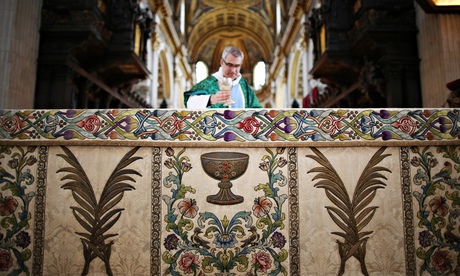An altar frontal that was once used by St Paul’s Cathedral in London is now seeing use once again for the first time in decades. The embroidered cloth was created by injured soldiers during World War I, but it had to be taken down during the Second World War when the cathedral was bombed. Now, following the start of the WWI centenary, the cathedral has resumed use of the iconic altar frontal.
The cloth’s first run of use began shortly after the First World War ended. Veterans, royalty, and national officials were all present for the event which marked its first use. The event was a celebration of peacetime, and as such it was a fitting gesture of symbolism to adorn the cathedral with an altar frontal created by injured soldiers. Over one hundred soldiers from at least four different nations had a hand in the cloth’s creation, weaving an exquisite and intricate embroidery design into the entire front face of the ornamental hanging. Now, their detailed and colorful work is on display for all to see.
Use of the soldiers’ creation halted in 1940. With the Second World War well underway, much of Britain fell prey to the Blitz. In the attack, St Paul’s Cathedral took heavy damage. The altar frontal could no longer be used, as there was nothing to put it on. Even when the cathedral was rebuilt, this important decoration was not included. This was not because the cloth was destroyed, but because it did not suit the size of the new dais installed in the cathedral, The Guardian reports.
Due to the large number of injured soldiers who worked on the cloth, and the vast number of different hospitals in which they were housed, it took some time before the entirety of the altar frontal was completed. London’s Royal School of Needlework took parts created by all of the soldiers and managed to combine them to make a single decoration. The main goal was simply to have patients doing stitch work, which was said to aid their recovery.
The current display of the altar frontal is a major event for the cathedral, and families of many of the men who helped to create the cloth in the first place have been invited to see it. In addition, the cathedral has posted some information about the cloth on their website. People are now able to learn much more about the altar frontal and those who created it, even if they are unable to attend the public display.
